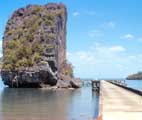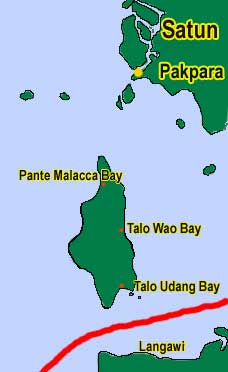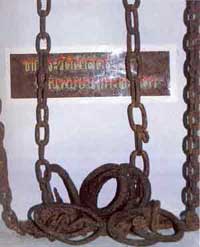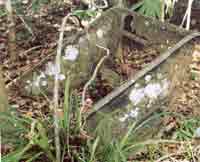The Koh Tarutao Story
The most popular cave at Tarutao is Crocodile Cave (Tam Jorakae). Tarutao is a mispronunciation of the Malay word “Ta Lo Trao,” which means plenty of bay. |
|
Imprison Area at Ta lo U-Dang Bay |
The construction was completed in June of 1941. The offices at Talo U-Dang Bay were used as a controlling area, Administration office, prisoners building, Police Box, Salt distillation building, and Kitchen. Most of the offices were constructed from the wood, the roof covered by palm leaf. The building at Talo Wao Bay was used for training programs for the prisoners. It was located on the high hill that is easily seen from the other buildings. |
On June 1941, the Prison Department sent the first group of 500 prisoners to Tarutao on September 1941. The second group of 500 prisoners were sent there later. The train from Bangkok to Kuan Nuang (Songkhla) was used for sending the prisoners. Then, the prisoners were transferred to Satun Province and then to “Koh Nok Pier” and tranferred by motorboat to Tarutao. Sometimes, “Kantang Pier” at Trang Province was used since the train from Bangkok can go straight to Kantang Pier. In 1943, the governor announced that Koh Tarutao and the surrounding area was a government secret of the Prison Department, and so the few people that lived in the area were forced to move.  The prisoners were subject to jail programs that trained them to work on rubber plantations, in the fishing industry, wood industry, and to make local products made from natural resources. The prisoners were subject to jail programs that trained them to work on rubber plantations, in the fishing industry, wood industry, and to make local products made from natural resources. From the record and from the rumours, there were nearly 10,000 prisoners sent there. After the old prisoners were gone, the new one would be replaced immediately. There were around a maximum of 3,000 prisoners at any one time. The biggest problem was accomadation. Therefore the governor needed to separate them to another area. The biggest unit was located at Talo Wao bay, which housed 2,000 prisoners. The smaller unit, located at Talo U-dang Bay, housed 600 prisoners. The third unit, located at Kramad Canal, the small bay near Talo Wao Bay, housed 200 prisoners.
In 1946, the prisoners revolted and became pirates. This was due to a lack of supplies brought about by World War II.
On the early morning of 15 March 1947, General Terray took 2 boats and 300 soldiers and arrived at Talo Wao Bay and ended the pirate troops.The British Troops departed from Tarutao on 23 March 1947. The Prison Department announced to close all of the Tarutao prisoner offices in 1949 and it became a vacant land.
|
|

 Well here it is, after all of the recent media interest in the island, many of you requested by e-mail information on the island's hisotry. Our guides have written this brief history of Koh Taratoa, and more will be added as researched.
Well here it is, after all of the recent media interest in the island, many of you requested by e-mail information on the island's hisotry. Our guides have written this brief history of Koh Taratoa, and more will be added as researched.
 There were some important political prisoners under control there. For example, Sor Settabut, who is the English - Thai dictionary translator.Sor Settabut interpretted English – Thai Dictionary “A-S” at Bang Kwang prison and “T” at Tarutao and finished it after being transferred to Koh Tao, Surattani. It is still published and used today.
There were some important political prisoners under control there. For example, Sor Settabut, who is the English - Thai dictionary translator.Sor Settabut interpretted English – Thai Dictionary “A-S” at Bang Kwang prison and “T” at Tarutao and finished it after being transferred to Koh Tao, Surattani. It is still published and used today. The formation of the pirates was started from a few of the prisoners who took the boat to get free food like rice, sugar, fish sauce, onion, and garlic from the local people and soon became more like the traditional pirates. They robbed and hijacked other boats and goods with the cooperation of the prison controllers and prisoners.
The formation of the pirates was started from a few of the prisoners who took the boat to get free food like rice, sugar, fish sauce, onion, and garlic from the local people and soon became more like the traditional pirates. They robbed and hijacked other boats and goods with the cooperation of the prison controllers and prisoners. The British, who governed Malaysia during that period, had to send soldiers and the navy to stop the threat of the pirates.
The British, who governed Malaysia during that period, had to send soldiers and the navy to stop the threat of the pirates. On 19 April 1975, the governor announced Koh Tarutao be the first Thai sea national park. UNESCO claimed Koh Tarutao as “Asian Heritage Parks and Reserves.
On 19 April 1975, the governor announced Koh Tarutao be the first Thai sea national park. UNESCO claimed Koh Tarutao as “Asian Heritage Parks and Reserves.